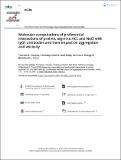| dc.contributor.author | Cloutier, Theresa K | |
| dc.contributor.author | Sudrik, Chaitanya | |
| dc.contributor.author | Mody, Neil | |
| dc.contributor.author | Hasige, Sathish A | |
| dc.contributor.author | Trout, Bernhardt L | |
| dc.date.accessioned | 2021-10-27T20:23:25Z | |
| dc.date.available | 2021-10-27T20:23:25Z | |
| dc.date.issued | 2020 | |
| dc.identifier.uri | https://hdl.handle.net/1721.1/135425 | |
| dc.description.abstract | © 2020 The Author(s). Published with license by Taylor & Francis Group, LLC. Preferential interactions of excipients with the antibody surface govern their effect on the stability of antibodies in solution. We probed the preferential interactions of proline, arginine.HCl (Arg.HCl), and NaCl with three therapeutically relevant IgG1 antibodies via experiment and simulation. With simulations, we examined how excipients interacted with different types of surface patches in the variable region (Fv). For example, proline interacted most strongly with aromatic surfaces, Arg.HCl was included near negative residues, and NaCl was excluded from negative residues and certain hydrophobic regions. The differences in interaction of different excipients with the same surface patch on an antibody may be responsible for variations in the antibody's aggregation, viscosity, and self-association behaviors in each excipient. Proline reduced self-association for all three antibodies and reduced aggregation for the antibody with an association-limited aggregation mechanism. The effects of Arg.HCl and NaCl on aggregation and viscosity were highly dependent on the surface charge distribution and the extent of exclusion from highly hydrophobic patches. At pH 5.5, both tended to increase the aggregation of an antibody with a strongly positive charge on the Fv, while only NaCl reduced the aggregation of the antibody with a large negative charge patch on the Fv. Arg.HCl reduced the viscosities of antibodies with either a hydrophobicity-driven mechanism or a charge-driven mechanism. Analysis of this data presents a framework for understanding how amino acid and ionic excipients interact with different protein surfaces, and how these interactions translate to the observed stability behavior. | |
| dc.language.iso | en | |
| dc.publisher | Informa UK Limited | |
| dc.relation.isversionof | 10.1080/19420862.2020.1816312 | |
| dc.rights | Creative Commons Attribution NonCommercial License 4.0 | |
| dc.rights.uri | https://creativecommons.org/licenses/by-nc/4.0/ | |
| dc.source | Taylor & Francis | |
| dc.title | Molecular computations of preferential interactions of proline, arginine.HCl, and NaCl with IgG1 antibodies and their impact on aggregation and viscosity | |
| dc.type | Article | |
| dc.contributor.department | Massachusetts Institute of Technology. Department of Chemical Engineering | |
| dc.relation.journal | mAbs | |
| dc.eprint.version | Final published version | |
| dc.type.uri | http://purl.org/eprint/type/JournalArticle | |
| eprint.status | http://purl.org/eprint/status/PeerReviewed | |
| dc.date.updated | 2021-06-22T15:50:22Z | |
| dspace.orderedauthors | Cloutier, TK; Sudrik, C; Mody, N; Hasige, SA; Trout, BL | |
| dspace.date.submission | 2021-06-22T15:50:24Z | |
| mit.journal.volume | 12 | |
| mit.journal.issue | 1 | |
| mit.license | PUBLISHER_CC | |
| mit.metadata.status | Authority Work and Publication Information Needed | |
